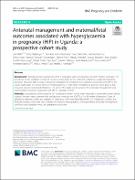| dc.contributor.author | Nakabuye, Betty | |
| dc.contributor.author | Sekitoleko, Isaac | |
| dc.contributor.author | Mubiru, Michael | |
| dc.contributor.author | Tumwesigire, Samuel | |
| dc.contributor.author | Tino, Salome | |
| dc.contributor.author | Mirembe, Sandy | |
| dc.contributor.author | Kakande, Ayoub | |
| dc.contributor.author | Agaba, Brian | |
| dc.contributor.author | Nansubuga, Faridah | |
| dc.contributor.author | Zaake, Daniel | |
| dc.contributor.author | Ayiko, Ben | |
| dc.contributor.author | Kalema, Herbert | |
| dc.contributor.author | Nakubulwa, Sarah | |
| dc.contributor.author | Sekikubo, Musa | |
| dc.contributor.author | Nakimuli, Annettee | |
| dc.contributor.author | Webb, Emily L. | |
| dc.contributor.author | Nyirenda, Moffat J. | |
| dc.contributor.author | Milln, Jack | |
| dc.contributor.author | Natamba, Barnabas Kahiira | |
| dc.date.accessioned | 2021-10-04T13:41:16Z | |
| dc.date.available | 2021-10-04T13:41:16Z | |
| dc.date.issued | 2021-05-19 | |
| dc.identifier.citation | Milln, J., Nakabuye, B., Natamba, B.K., Sekitoleko, I., Mubiru, M., Namara, A.A., Tumwesigire, S., Tino, S., Mirembe, M., Kakande, A. and Agaba, B., 2021. Antenatal management and maternal/fetal outcomes associated with hyperglycaemia in pregnancy (HIP) in Uganda; a prospective cohort study. BMC pregnancy and childbirth, 21(1), pp.1-9. | en_US |
| dc.identifier.uri | http://hdl.handle.net/20.500.12280/2839 | |
| dc.description.abstract | Background: Hyperglycaemia in pregnancy (HIP) is associated with complications for both mother and baby. The
prevalence of the condition is likely to increase across Africa as the continent undergoes a rapid demographic
transition. However, little is known about the management and pregnancy outcomes associated with HIP in the
region, particularly less severe forms of hyperglycaemia. It is therefore important to generate local data so that
resources may be distributed effectively. The aim of this study was to describe the antenatal management and
maternal/fetal outcomes associated with HIP in Ugandan women.
Methods: A prospective cohort study of 2917 pregnant women in five major hospitals in urban/semi-urban central
Uganda. Women were screened with oral glucose tolerance test (OGTT) at 24–28 weeks of gestation. Cases of
gestational diabetes (GDM) and diabetes in pregnancy (DIP) were identified (WHO 2013 diagnostic criteria) and
received standard care. Data was collected on maternal demographics, anthropometrics, antenatal management,
umbilical cord c-peptide levels, and pregnancy outcomes.
Results: Two hundred and seventy-six women were diagnosed with HIP (237 classified as GDM and 39 DIP).
Women had between one and four fasting capillary blood glucose checks during third trimester. All received
lifestyle advice, one quarter (69/276) received metformin therapy, and one woman received insulin. HIP was
associated with large birthweight (unadjusted relative risk 1.30, 95% CI 1.00–1.68), Caesarean delivery (RR 1.34, 95%
CI 1.14–1.57) and neonatal hypoglycaemia (RR 4.37, 95% CI 1.36–14.1), but not perinatal mortality or preterm birth.
Pregnancy outcomes were generally worse for women with DIP compared with GDM.
Conclusion: HIP is associated with significant adverse pregnancy outcomes in this population, particularly overt
diabetes in pregnancy. However pregnancy outcomes in women with milder forms of hyperglycaemia are similar
to those with normoglycaemic pregnancies. Intervention strategies are required to improve current monitoring and
management practice, and more research needed to understand if this is a cost-effective way of preventing poor
perinatal outcomes. | en_US |
| dc.language.iso | en | en_US |
| dc.publisher | BMC | en_US |
| dc.title | Antenatal Management and Maternal/fetal Outcomes associated with hyperglycaemia in pregnancy (HIP) in Uganda: A prospective cohort study | en_US |
| dc.type | Article | en_US |


